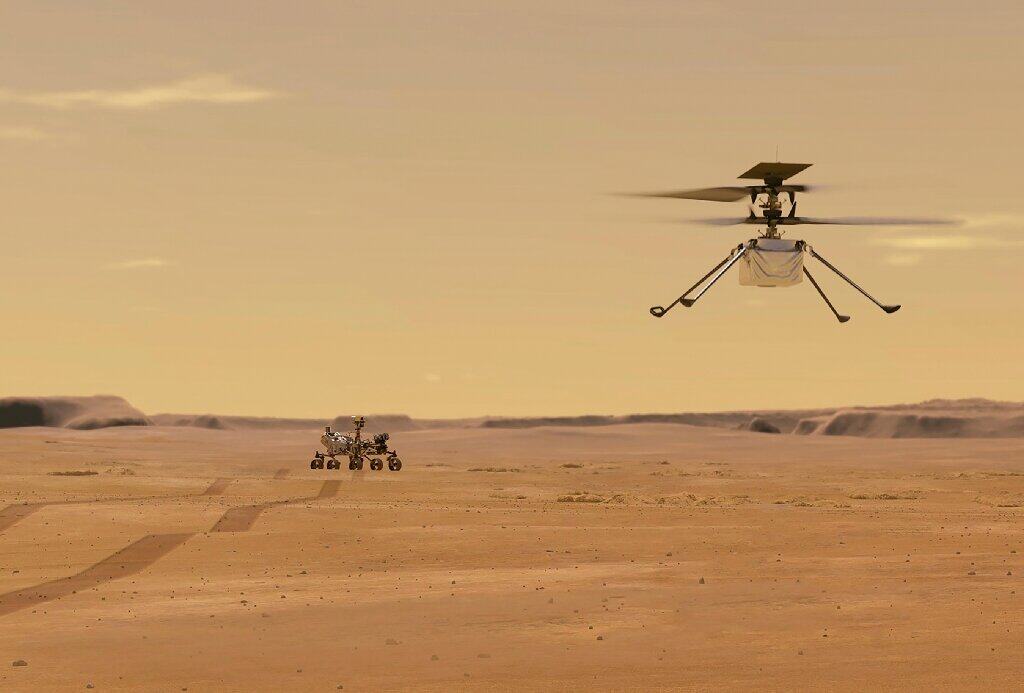

The first helicopter ever to fly on another planet will soon attempt its first trip above the surface of Mars.
Carried under the belly of the Perseverance rover, the helicopter, a drone-like device named “Ingenuity,” will test the feasibility of Mars flight. This is a difficult challenge compared with flight on Earth, because the Martian atmosphere is only 1% as dense as Earth’s at the surface.
Ingenuity will be a technology demonstration for the Mars 2020 mission, but one day such rotorcraft could provide reconnaissance for rovers to help guide their routes, said Rob Sullivan, a research scientist at the Cornell Center for Astrophysics and Planetary Science and a member of the Mars 2020 science team.


Currently, pictures taken from orbit help determine a rover’s route. Those images are impressively good – as high as 25 centimeters per pixel – but still not as good as images obtained from the rover.
“Inevitably the rover encounters things at ground scale that are totally unexpected, which can change the mission team’s mind about what’s important,” Sullivan said.
Identifying a safe place where Ingenuity could conduct its flight tests was Perseverance’s first task. The helicopter needs a relatively flat surface of mostly soil with no large rocks. Martian soil usually includes rock fragments of various sizes, mixed with sand, silt and dust-sized grains, according to Sullivan.
Martian soil characteristics are important to rovers as well as rotorcrafts. Back in 2010, Sullivan and a team of students spent months doing soil tests with different materials and a rover wheel to understand how soil properties affect rover wheel performance, on behalf of the Mars Exploration Rover mission.
“Knowing something about the physical properties of the Martian soil you‘ll be driving on can be a confidence builder when planning a typical day’s rover drive on Mars,” Sullivan said. “Mars can be a hazardous place. Depending on soil properties, certain soil and slope combinations can cause problems and mission delays that cost time that we can’t get back at the end of the mission. We need to be efficient getting from place to place, every time.”
The Mars 2020 mission also includes a soils working team, on which Sullivan serves.
Understanding Mars’ landscape also requires understanding aeolian (wind-related) processes, said Sullivan, which has been his focus with Mars 2020. Because Mars has been extremely dry for most of its history, aeolian processes have contributed much more significantly to shaping the landscape on Mars than on Earth. Erosion of surface rocks by wind-blown sand grains has shaped entire landscapes, and the tiny grains performing this work can also accumulate into sedimentary rocks that preserve a long record of Martian history.
Sullivan came to Cornell in 1997 and has worked on every rover mission to Mars, including the Spirit and Opportunity rovers, for which Steve Squyres ‘78, Ph.D. ‘81, the James A. Weeks Professor of Physical Sciences Emeritus, was the principal investigator. Sullivan also worked on the Mars Pathfinder, which delivered the first successful Martian rover to the red planet. Like Ingenuity, that rover, named Sojourner, was also a technology demonstration.
Sullivan has also explored Jupiter and the asteroid belt as part of the Galileo mission.
“I’m extremely lucky to get to do what I do. It’s very humbling,” Sullivan said. “My colleagues are truly inspiring, are such impressive persons that I deeply admire. I’ve learned a lot from how clearly they think and how articulate they are in sharing what they know and how they do their jobs.”
On any spaceflight mission, tight teamwork is essential and makes the work enjoyable, says Sullivan. For previous rover missions, the whole science team would live and work together for the first several weeks so everyone could learn their roles, perfect their coordination, and fine-tune their efficiency as a team. But because of the pandemic, the Mars 2020 mission has had to operate almost entirely virtually from the start.
“That’s sort of the miracle of this mission,” Sullivan said. “Numerous delicate, critical and complicated tasks have to be coordinated and carried out by remote individuals, for a rover that’s many times even more remote.”
Perseverance’s main goal is to collect samples that will later be picked up by a follow-on mission and returned to Earth. The samples will help scientists determine if life ever evolved, or began to evolve, on the Red Planet.
Bringing Mars samples back to Earth, rather than analyzing them in place with just a few small instruments that a rover can carry, will be a powerful investment in the future, Sullivan said.
“Like the Lunar samples Apollo brought back, we’ll have these Mars samples forever,” he said, “allowing scientists of the future to apply superior apparatus than currently available in their analyses of these samples.”
Linda B. Glaser is news and media relations manager for the College of Arts and Sciences. This article is adapted from the original, “Roving Mars, by air and land,” which appeared April 7 on the College of Arts and Sciences’ website.






































